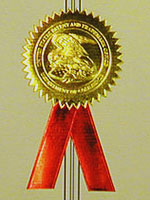Patent issued to OSE faculty for WGM-based sensors
Departmental News

Posted: November 15, 2016
The United States Patent Office issued Patent No. US 9,482,608 on November 1, 2016 for "WGM-based molecular sensors" to University of New Mexico inventors and CHTM and OSE faculty members Ravinder Jain and Mani Hossein-Zadeh. Jain is a Professor of Electrical & Computer Engineering with a joint appointment in Physics & Astronomy. Hossein-Zadeh is an Associate Professor of Electrical and Computer Engineering and the leader of the Microwave Photonics Group.
Ravinder Jain
Abstract
The present invention concerns an optical molecular sensing device and related method. The optical molecular sensing device has an optical resonator adapted to be connected to an excitation source. The excitation source may be a laser operating at a 2.7-2.8 um spectral range. The optical molecular sensing device has an emission spectrum comprised of a plurality wavelengths. Also included are a detection unit and a RF frequency counter to detect at least one RF beat note resulting from detecting the emission spectrum of the optical resonator. A change in frequency of the RF beat note indicates the presence of a target molecule.

Mani Hossein-Zadeh
Excerpt from Background
High optical quality (high-Q) whispering gallery mode (WGM) microresonators have been a subject of intense investigation during the last decade because of their strong potential for numerous high-performance photonic devices, including ultra-sensitive molecular detectors and advanced light sources, such as narrow linewidth lasers and comb generators. The unique characteristics of such WGM devices appear to be particularly relevant for mid-infrared (MIR) applications, because of the stronger molecular absorption lines in the MIR, and because of the increasing need for frequency comb sources in this "molecular fingerprint" region. In particular, prior efforts have estimated a sensitivity of a few parts per trillion for the detection of several strongly-absorbing atmospheric and biogenic trace gases in this MIR "molecular fingerprint" region by combining the sensitivity benefits of wavelength modulation spectroscopy with high-Q MIR microsensors in compact "field-usable devices", facilitating their use for numerous applications in industry, environmental sensing, and agriculture. Such miniature portable "ultra-sensitive" molecular sensors could pave the way for numerous cutting-edge uses in diverse fields and applications such as: (1) breath analysis of patients for healthcare; (2) process control systems (such as ultrasensitive moisture monitoring) in manufacturing; (3) environmental monitoring of industrial pollutants, including hydrogen sulphide and carbon monoxide levels (say on roadsides and in parking structures); (4) the precise monitoring of trace gases that affect the environment, such as CO.sub.2 and other greenhouse gases, biogenic emissions from flora and fauna, coastal and oceanic carbon and nitrogen compounds, and geothermal and volcanic emissions; and (5) measurements of emissions from agricultural enterprises including crop growth and livestock farming (e.g., ammonia emissions).
Brief Summary of the Invention
In one embodiment, the present invention exploits the strong dispersion of resonant modes near molecular absorption lines, and reduces the cost and complexity of molecular sensors by eliminating the need for tunable lasers; moreover, the detection speed of the present invention is much faster, and limited only by the cavity buildup time (typically of the order of nanoseconds or less), enabling "real time" monitoring. In addition, other embodiments of the microlaser of the present invention are not based on electrically-pumped semiconductor sources or require cryogenic temperatures to operate. Embodiments of the present invention are able to operate in temperature from 32 degrees below zero and higher.
In other embodiments, the present invention provides a room temperature MIR WGM microlaser operating in the 2.7-2.8 um spectral range where there are a plethora of molecular absorption lines. This embodiment was achieved by fabricating high-Q erbium-doped ZBLAN microspheres and optically pumping such Er:ZBLAN microspheres with a 980 nm diode laser. Using elevated erbium concentrations enables mid-IR WGM laser generation.
In another embodiment, the present invention provides a continuous-wave (cw) room temperature (RT) mid-IR WGM microlaser system capable of operating at a spectral range (2.7-2.8 .mu.m) that overlaps strong transitions of several molecular species of significant interest for sensing applications. Applications for the embodiments of the present invention include, but are not limited to, detection at trace levels for: (1) environmental sensing (NO.sub.2, CO.sub.2, CO, H.sub.2S, and AsH.sub.3), (2) industrial process monitoring (trace water vapor levels for semiconductor fab and fiber preform manufacturing), and (3) health care (including breath analysis). In one embodiment, the cw MIR microlasers may be achieved by optically pumping high-Q WGM spherical erbium-doped fluoride glass microresonators with a low-power 980 nm diode laser.
Source:
U.S. Patent No: 9,482,608
